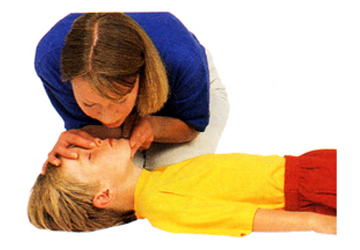Child Breathing
“B” is for BREATHING (you may skip this section if doing compression-only CPR)
While supporting the child’s chin keeping it lifted up and the head tilted back, pinch his nose – or for a smaller child,  cover his mouth and nose with your mouth – to create a tight seal prevent air from escaping once you begin to ventilate (use a shield barrier if one is available). Give 2 breaths for approximately 1 second each. Keep in mind that depending on the age and size, a child’s lungs may have much smaller capacity than those of an adult. When ventilating a child, be sure to use shallower breaths and keep an eye on the his chest to avoid stomach distention. If this happens and the child vomits, turn his head sideways and sweep all obstructions out of the mouth before proceeding. Between each breath allow the victim’s lungs to relax – place your ear near his mouth and listen as the air escapes and watch the chest fall as he exhales. If the child victim remains unresponsive (no breathing, coughing or moving), check his circulation.
cover his mouth and nose with your mouth – to create a tight seal prevent air from escaping once you begin to ventilate (use a shield barrier if one is available). Give 2 breaths for approximately 1 second each. Keep in mind that depending on the age and size, a child’s lungs may have much smaller capacity than those of an adult. When ventilating a child, be sure to use shallower breaths and keep an eye on the his chest to avoid stomach distention. If this happens and the child vomits, turn his head sideways and sweep all obstructions out of the mouth before proceeding. Between each breath allow the victim’s lungs to relax – place your ear near his mouth and listen as the air escapes and watch the chest fall as he exhales. If the child victim remains unresponsive (no breathing, coughing or moving), check his circulation.